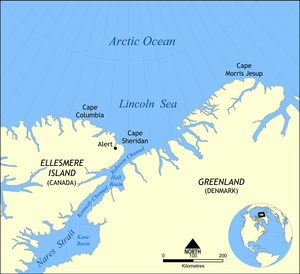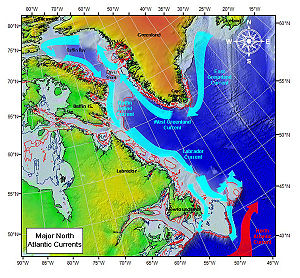Baffin Bay
 | |
| Coordinates | 73°N 67°W / 73°N 67°W |
| Max. length | 1,450 km (901 mi) |
| Max. width | 110–650 km (68–404 mi) |
| Surface area | 689,000 km2 (266,000 sq mi) |
| Average depth | 861 m (2,825 ft) |
| Max. depth | 2,136 m (7,008 ft) |
| Water volume | 593,000 km3 (142,300 cu mi) |
| References | [1][2] |
Baffin Bay (Inuktitut: Saknirutiak Imanga,[3] French: Baie de Baffin), located between Baffin Island and the southwest coast of Greenland, is a marginal sea of the North Atlantic Ocean.[1][2][4] It is connected to the Atlantic via Davis Strait and the Labrador Sea. A narrower Nares Strait connects Baffin Bay with the Arctic Ocean.
The bay area was inhabited from around 500 BC by the Dorset and then Thule and Inuit people. It was reached by Europeans in 1585 and described in detail in 1616 by William Baffin, after whom the bay and the island are named. The bay is not navigable most of the year because of the ice cover and high density of floating ice and icebergs in the open areas. However, a polynya of about 80,000 km2 (31,000 sq mi), known as the North Water, opens in summer on the north near Smith Sound.[5] Most of the aquatic life of the bay is concentrated near that region.

History
In 1585, British explorer, John Davis, was the first recorded European to enter the bay.[6] Later, between 1612 and 1616, William Baffin made five expeditions to the Arctic; together with Robert Bylot, he reached and explored the Baffin Bay in 1616. He also proved that no Northwest Passage was in the Hudson Bay area.[7][8] The reports by Baffin and Bylot were questioned in England and in 1818, the bay was "rediscovered" by John Ross.[9] More advanced scientific studies followed in 1928, in the 1930s and after World War II by Danish, American and Canadian expeditions.[2]
The northern coast of area of the bay was occupied by the Dorset (500 BC – 1200 AD) and then Thule and Inuit people. Currently, there are a few Inuit settlements on the Canadian coast of the bay, including Arctic Bay (population 690), Pond Inlet (1,315) and Clyde River (820). Those settlements are accessed and supplied by air and annual sealifts. In 1975, a town was built at Nanisivik to support lead and zinc production at the Nanisivik Mine – the first Canadian mine in the Arctic. The mine was permanently closed in 2002 due to declining resources and metal prices. Whereas the town still has an operational seaport and an airport, as of the Canada 2006 Census, it has a population of zero.[10][11][12]
Baffin Bay was the epicenter of a 7.3 magnitude earthquake in 1933. This is the largest known earthquake north of the Arctic Circle. It caused no damage because of its offshore location and the small number of the nearby onshore communities. The northwestern part of the bay remains one of the most seismically active regions in eastern Canada, and with five earthquakes of magnitude 6 have occurred here since 1933. The latest strong earthquake occurred on 15 April 2010 and had the magnitude of 5.1.[13]

Extent
The International Hydrographic Organization defines the limits of Baffin Bay as follows:[14]
On the North. A line from Cape Sheridan, Grant Land (82°35′N 60°45′W / 82.583°N 60.750°W) to Cape Bryant, Greenland.
On the East. The West Coast of Greenland.
On the South. The parallel of 70° North between Greenland and Baffin Land.
On the West. The Eastern limits of the North-West Passages [The East Coast of Ellesmere Island between C. Sheridan and Cape Norton Shaw (76°29′N 78°30′W / 76.483°N 78.500°W), thence across to Phillips Point (Coburg Island) through this Island to Marina Peninsula (75°55′N 79°10′W / 75.917°N 79.167°W) and across to Cape Fitz Roy (Devon Island) down the East Coast to Cape Sherard (Cape Osborn) (74°35′N 80°30′W / 74.583°N 80.500°W) and across to Cape Liverpool, Bylot Island (73°44′N 77°50′W / 73.733°N 77.833°W); down the East coast of this island to Cape Graham Moore, its southeastern point, and thence across to Cape Macculloch (72°29′N 75°08′W / 72.483°N 75.133°W) and down the East coast of Baffin Island to East Bluff, its Southeastern extremity, and thence the Eastern limit of Hudson Strait].
— International Hydrographic Organization, Limits of Oceans and Seas, 3rd edition
Geography and geology

Baffin Bay is an arm of the Atlantic Ocean bounded by the Baffin Island in the west, Greenland in the east, and Ellesmere Island in the north. It connects to the Atlantic through the Davis Strait, and to the Arctic through several narrow channels of Nares Strait. It is a northwestern extension of the North Atlantic and Labrador Sea. It can also be viewed as a long strait separating Baffin Island and Greenland.[2][15]
The bay is less than 1,000 m (3,300 ft) deep near the coast, where the sea bottom is covered with gravel, crushed stone and sand. In the center, there is a deep pit called Baffin Hollow reaching 2,136 m (7,008 ft) (see depth map), which is mostly covered in silt. Currents form a cyclonic circulation. On the eastern periphery, in summer, the West Greenland Current transports water from the Atlantic Ocean to the North. In its western part, the Baffin Island Current brings the Arctic waters to the south.[1]
Climate, hydrology and hydrochemistry

The climate is Arctic with frequent storms, especially in winter. Average January temperatures are −20 °C (−4 °F) in the south and −28 °C (−18 °F) on the north. In July, the average temperature is 7 °C (45 °F). The annual precipitation is 100–250 mm (3.9–9.8 in) on the Greenland side and about twice larger near the Baffin Island.[2]
The water temperature at the surface is below −1 °C (30 °F) in winter. In summer, it varies from 4–5 °C (39–41 °F) in the south-east to 0 °C (32 °F) and below at north-west. The salinity exceeds 34‰ (parts per thousand) in winter. In summer, it is 32‰ on the east and 30–31‰ on the west. Deep waters are formed as a result of mixing of Arctic and Atlantic waters; their temperature is about −0.5 °C (31.1 °F) and salinity is 34.5 ‰. In winter, 80% of the bay is covered with continuous ice, floating ice and fast ice. In some winters, the continuous ice stretches from shore to shore. The ice is most abundant in March and least in August–September. In summer, drifting ice remains in the central and western parts of the bay. Numerous icebergs are formed in this period and are brought, together with ice, to the Atlantic Ocean near Newfoundland.[1][16]
The tides are semidiurnal, with an average height of 4 m (13 ft) and the maximum of 9 m (30 ft). Their speed varies between 1 and 3.7 km/h (0.62 and 2.30 mph) hour and the direction by as much as 180°. This variability results in in the collision and crushing of fresh, old, and pack ice.[2] Winds are predominantly north-western through the whole year. South-eastern and eastern winds are common in July and August.[1][16]
North Water
Between May and July (sometimes April), a significant portion of navigable open water (polynya) forms at the extreme north of the bay, presumably due to the relatively warm Greenland Current.[2] With an area of about 80,000 km2 (31,000 sq mi) in summer, it is the largest polynya of the Canadian Arctic and covers the Smith Sound between the Ellesmere Island and Greenland. This polynya has a stable position and existed for at least 9,000 years. It was first described in 1616 by William Baffin and was named North Water by whalers of the 18–19th centuries.[16][17]
Wildlife

The North Water provides air to ice algae and zooplankton and is characterized by abundant fauna. Of about 20,000 Beluga whales living in the Baffin Bay, some 15,000 are concentrated at the North Water.[18] Other abundant animals of the region include walrus, narwhal, Harp Seal, bearded seal, ringed seal and polar bear. All aquatic mammals crucially depend on the availability of open water; they have very limited ability to maintain breathing holes in ice and are all vulnerable to attacks by the polar bear when breathing at the holes. The seals and walrus occupy areas of fast ice, which is essential for giving birth and raising the pups. Bearded seals feed near the bottom of the bay and therefore are restricted to the shallow waters. Ringed seal is the most common meal of the polar bear. It is also an occasional prey of the walrus and Arctic Fox.[19] Most large animals of the bay are being traditionally hunted, but the hunting has been restricted in the 20th century in order to preserve the wildlife population. For example, the quota for polar bears in the bay area is 105 per year.[20]
There are about 400 plant and tree species on the bay shores, including birch, willow, alder and plants adapted to salty soils, as well as lyme grass, mosses, and lichens. These serve as food for caribou and rodents, such as lemming. Resident fish species include polar cod, Arctic flounder (Pleuronectidae, Liopsetta), four-horned sculpin and capelin, whereas cod, haddock, herring, halibut, and rattail migrate from the Atlantic. The birds are represented by the Little Auk, Snowy Owl, Willow Ptarmigan, Rock Ptarmigan, Gyrfalcon, Arctic Redpoll and guillemots. Most of them migrate to the south during the winter.[2][21][22]
See also
References
- ^ a b c d e Baffin Bay, Great Soviet Encyclopedia (in Russian)
- ^ a b c d e f g h Baffin Bay, Encyclopædia Britannica on-line
- ^ Wissenladen.de
- ^ Reddy, M. P. M. (2001). Descriptive Physical Oceanography. Taylor & Francis. p. 8. ISBN 978-90-5410-706-4. Retrieved 26 November 2010.
- ^ Circulation and generation of the North Water Polynya, Northern Baffin Bay
- ^ John Davis, Encyclopædia Britannica on-line
- ^ William Baffin, Encyclopædia Britannica on-line
- ^ Discovery and Exploration of Canada
- ^ Mowat, Farley (1967). The Polar Passion: The Quest for the North Pole. Toronto: McClelland and Stewart Limited, p. 43
- ^ "Government will continue seeking positive legacy from Nanisivik mine closure, minister says". Archived from the original on 13 March 2007. Retrieved 20 August 2007.
- ^ Canadian Mines Handbook 2003-2004. Toronto, Ontario: Business Information Group. 2003. ISBN 0-919336-60-4.
- ^ Statistics Canada
- ^ Natural Resources Canada: The 1933 Baffin Bay earthquake
- ^ "Limits of Oceans and Seas, 3rd edition" (PDF). International Hydrographic Organization. 1953. Retrieved 6 February 2010.
- ^ Chisholm, Hugh, ed. (1911). . Encyclopædia Britannica (11th ed.). Cambridge University Press.
- ^ a b c National Geospatial-intelligence Agency (2005-01). Prostar Sailing Directions 2005 Greenland and Iceland Enroute. p. 73. ISBN 978-1-57785-753-2.
{{cite book}}: Check date values in:|date=(help) - ^ Levac, Elisabeth; Vernal, Anne De; Blake Jr, Weston (2001). "Sea-surface conditions in northernmost Baffin Bay during the Holocene: palynological evidence" (PDF). Journal of Quaternary Science. 16 (4): 353. doi:10.1002/jqs.614.
- ^ COSEWIC Assessment and Update Status Report on the Beluga Whale
- ^ K. J. Finley and W. E. Renaud (l980). "Marine Mammals Inhabiting the Baffin Bay North Water in Winter" (PDF). Arctic. 33 (4): 724–738.
{{cite journal}}: Check date values in:|year=(help) - ^ Proposed Baffin Bay polar bear quota rejected, CBC News, 28 January 2010
- ^ E. C. Pielou (1 November 1994). A naturalist's guide to the Arctic. pp. 235, 292. ISBN 978-0-226-66814-7.
- ^ Maurice L. Schwartz (2005). Encyclopedia of coastal science. p. 48. ISBN 1-4020-1903-3.
